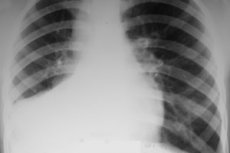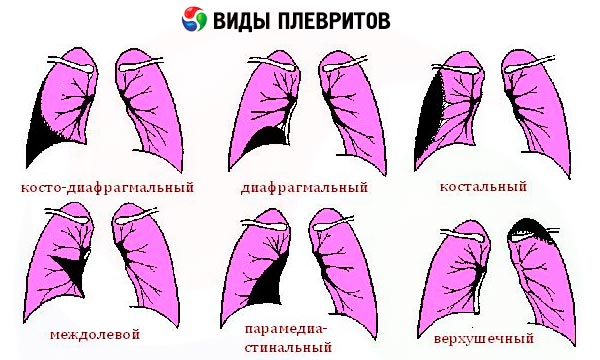Medical expert of the article
New publications
Pleural syndrome
Last reviewed: 08.07.2025

All iLive content is medically reviewed or fact checked to ensure as much factual accuracy as possible.
We have strict sourcing guidelines and only link to reputable media sites, academic research institutions and, whenever possible, medically peer reviewed studies. Note that the numbers in parentheses ([1], [2], etc.) are clickable links to these studies.
If you feel that any of our content is inaccurate, out-of-date, or otherwise questionable, please select it and press Ctrl + Enter.

Pleural syndrome is a set of symptoms characteristic of damage to the pleural sheets (inflammation, tumor) and (or) accumulation of fluid (exudate, transudate, blood, pus) or gas in the pleural cavity; sometimes inflammation of the pleural sheets (dry pleurisy) precedes the appearance of pleural fluid; in addition, fluid and gas can be detected simultaneously in the pleural cavity.
In dry pleurisy, during breathing, a lag is noted in the affected half of the chest, since due to severe pain, the patient spares this area. Auscultation over the affected half of the chest reveals a rough pleural friction noise, equally loud throughout the entire inhalation and exhalation, blocking vesicular breathing; sometimes pleural friction is clearly felt during palpation.
Accumulation of fluid in the pleural cavity (hydrothorax), which may be exudate, transudate, pus (pyothorax, pleural empyema ), blood ( hemothorax ) or of a mixed nature, is accompanied by smoothing of the intercostal spaces and even bulging of the affected half of the chest, a lag in breathing, and vocal fremitus is not transmitted to this side. Comparative percussion reveals a sharp dullness or absolute dullness of the percussion sound, above the upper border of which a poorly ventilated compressed lung gives it a dull-tympanic tint. Topographic percussion reveals features of the upper border of dullness, which, as already mentioned, can have a different direction depending on the nature of the fluid, as well as a significant limitation of the mobility of the lower edge of the compressed lung. Auscultation reveals a sharp weakening of vesicular breathing or, more often, its absence above the dullness zone, weakening of vesicular breathing above this zone, and with an oblique direction of the upper line of the dullness zone ( exudative pleurisy ), part of the more compressed lung (closer to the spine) is adjacent to the large bronchi, therefore an area is formed where bronchial breathing is heard against the background of a dull-tympanic percussion sound (Garland's triangle). With exudative pleurisy, another small area is sometimes distinguished, adjacent to the spine in the lower part of the dullness zone and already on the healthy side, where, as a result of some displacement of the aorta, dullness of the percussion sound and absence of breathing are determined during auscultation (Rauchfuss-Grocco triangle).

The presence of gas in the pleural cavity ( pneumothorax ) is indicated by characteristic symptoms that allow this condition to be diagnosed even before radiography. During examination and palpation of the affected half of the chest, smoothing of the intercostal spaces, a lag in breathing, and weakening of the vocal fremitus are revealed. The percussion sound over this zone is tympanic in nature; with a large pneumothorax, the lower border of tympanitis falls below the normal border of the lungs due to the expansion of the pleural sinuses.
In the simultaneous presence of gas and fluid (hydropneumothorax, pyopneumothorax, hemopneumothorax), percussion over the affected half of the chest reveals a combination of dull (lower part) and tympanic (upper part) sound tones.
Auscultation allows us to detect the absence of vesicular breathing (or its sharp weakening), and in the case of so-called valvular pneumothorax, when there is a connection between the pleural cavity and the respiratory tract, and with each breath a new portion of air enters it, bronchial breathing can be heard (also only on inhalation).


 [
[